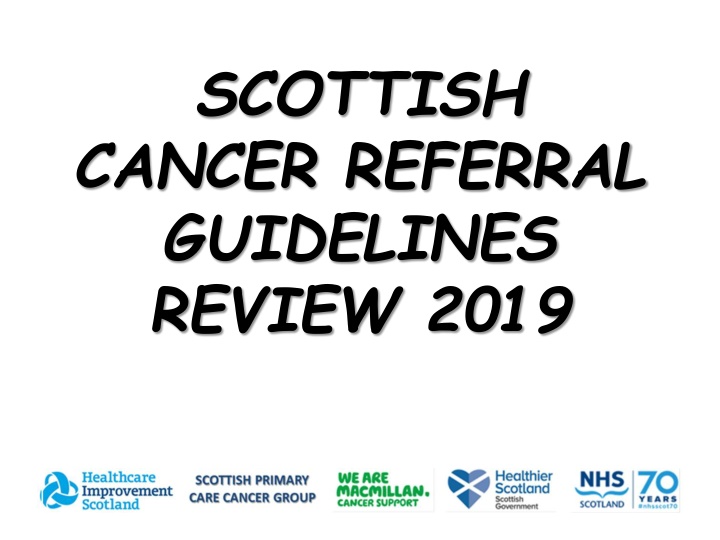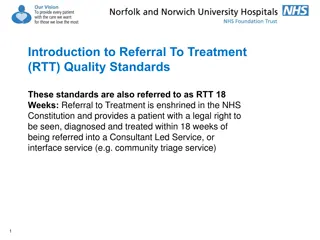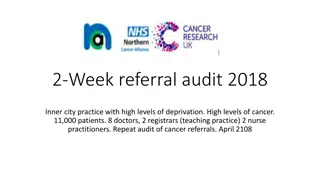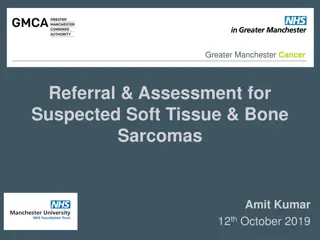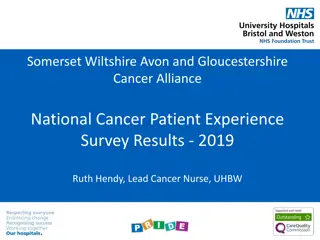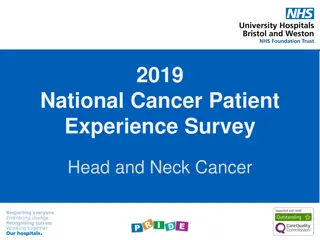Scottish Cancer Referral Guidelines Review 2019
The Scottish Cancer Referral Guidelines were reviewed in 2019 by multidisciplinary subgroups. Changes were made in various cancer sections, while keeping some sections unchanged. The review aimed to incorporate new evidence and ensure timely and appropriate referrals, prioritizing Urgent Suspicion of Cancer cases. The initiative also highlighted the importance of Realistic Medicine, patient-centered care, and communication in decision-making processes.
Download Presentation

Please find below an Image/Link to download the presentation.
The content on the website is provided AS IS for your information and personal use only. It may not be sold, licensed, or shared on other websites without obtaining consent from the author.If you encounter any issues during the download, it is possible that the publisher has removed the file from their server.
You are allowed to download the files provided on this website for personal or commercial use, subject to the condition that they are used lawfully. All files are the property of their respective owners.
The content on the website is provided AS IS for your information and personal use only. It may not be sold, licensed, or shared on other websites without obtaining consent from the author.
E N D
Presentation Transcript
SCOTTISH CANCER REFERRAL GUIDELINES REVIEW 2019
BACKGROUND need for changes identified by Scottish Primary Care Cancer Group this was a light touch refresh, not a complete re-write of the 2014 guidelines multidisciplinary subgroups (GPs, specialists, nurses, third sector, Scottish Government, etc.) met to consider new evidence provided by Healthcare Improvement Scotland (HIS) draft out sent for peer review (>100 responses) cancer sections changed: lung, breast, lower GI, upper GI, urological, head & neck, brain & CNS, and children, teenagers & young adults (CTYA) not changed: gynaecology, haematology, dermatology, malignant cord compression
REALISTIC MEDICINE [new] Realistic Medicine - Scottish Government initiative: person at the centre of decision-making personalised approach to their care good communication is key five questions to be considered by all involved: Is this action really needed? What are the benefits and risks? What are the possible side effects? Are there alternative options? And, importantly, what would happen if we did nothing?
REFERRAL PRIORITY Urgent Suspicion of Cancer (USOC) Referral prioritised tracked audited patient should receive first treatment within 62 days of receipt of referral referring clinician should receive timely feedback where negative results are found and concerns still exist, the specialist should consider direct onward referral to another specialty
DOWNGRADING REFERRAL PRIORITY Downgrading of USOC referrals referring clinician must be informed timeously give the clinician the opportunity to explain why an urgent referral was requested - information may have been omitted from the referral or may have become available since the referral was made essential that the patient is kept informed
PERFORMANCE STATUS [new] Include fitness / performance status in the referral facilitates discussion about best pathway
ACCESS TO IMAGING [new] Vague symptoms unknown primary unwell patients with significant unexplained weight loss not clear which pathway to refer in to most NHS Boards have pathways for Primary Care access to CT chest, abdomen and pelvis as first investigation strict criteria for referral local guidelines these patients would require 3-dimensional imaging at some stage so no extra load on radiology speeds up access to the correct pathway
THROMBOCYTOSIS [new] Thrombocystosis risk marker for malignancy, in particular (LEGO-C) lung endometrial gastric oesophageal colorectal cancer incidence 11.6% and 6.2% in males and females respectively (well exceeds the 3% threshold) persistently high platelet count should raise suspicion and prompt early investigation
LUNG Urgent suspicion of cancer referral for CXR haemoptysis unexplained persistent (>3 weeks): cough new or change chest/shoulder pain weight loss hoarseness (refer ENT if nothing else to suggest lung) dyspnoea appetite loss [new] chest signs fatigue (in smokers >40 years) [new] clubbing (new or not previously documented) chest infection persistent or recurrent [new] lymphadenopathy persistent cervical/supraclavicular (refer ENT if CXR normal) thrombocytosis (if CXR normal consider other diagnosis) [new]
LUNG Urgent suspicion of cancer referral unexplained signs/symptoms as above persisting for >6 weeks despite normal CXR CXR suggestive of lung cancer persistent haemoptysis >40 years and smoker/ex-smoker [new was >50]
LUNG Good practice points consider checking FBC and renal function if not done in preceding 3 months to expedite further imaging consolidation on chest X-ray should have further imaging no more than 6 weeks later radiology should notify respiratory team of chest X-ray suggestive of cancer consider CT chest, abdomen and pelvis if features suggestive of cancer (including suspected metastatic disease) but no other signs to suggest the primary source
BREAST Lump Urgent suspicion of cancer referral any new discrete lump in patients >30 years [new was >35] new asymmetrical nodularity >35 years & persists after 2-3 weeks unilateral isolated axillary lymph node persisting after 2-3 weeks [new no review previously] recurrent lump at site of previously aspirated cyst Routine referral new discrete lump <30 years with no other suspicious features new asymmetrical nodularity <35 years that persists after 2-3 weeks Primary care management longstanding tender lumpy breasts and no focal lesion tender developing breasts in adolescents
BREAST Nipple symptoms Urgent suspicion of cancer referral visibly bloodstained discharge new unilateral nipple retraction nipple eczema despite moderately potent topical steroids for minimum of 2 weeks [new was after 1% hydrocortisone] Routine referral persistent unilateral spontaneous discharge staining outer clothes Primary Care management transient nipple discharge not bloodstained check prolactin levels in persistent bilateral discharge longstanding nipple retraction nipple eczema if eczema present elsewhere
BREAST Skin changes Urgent suspicion of cancer referral skin tethering fixation ulceration peau d orange Primary Care management obvious simple skin lesions such as epidermoid (sebaceous) cysts
BREAST Abscess / infection Urgent suspicion of cancer referral mastitis or breast inflammation which does not settle or recurs after one course of antibiotics Primary Care management abscess or inflammation try one course of antibiotics as per local guidelines any acute abscess requires immediate discussion with secondary care
BREAST Pain Routine referral unilateral pain persisting >3 months in post-menopausal women intractable pain that interferes with lifestyle or sleep Primary Care management moderate degrees of breast pain and no discrete palpable lesion
BREAST Gynaecomastia Routine referral exceptional aesthetics referral to plastic surgery pathway if appropriate exclude or treat any endocrine cause prior to referral Primary Care management examine and exclude abnormalities such as lymphadenopathy or evidence of endocrine condition with blood tests as per local guidelines review to exclude drug causes
BREAST Breast implants [new] Routine referral if appropriate, refer to the service that first inserted the implant (usually plastic surgery) Primary care management reassurance is often appropriate if symptoms relate to the implant alone and not to underlying breast tissue Gender reassignment [new] provide sensitive and clinically appropriate care depending on individual circumstances and taking into account any hormone therapy involved
LOWER GI Urgent suspicion of cancer referral bleeding repeated rectal bleeding (without an obvious anal cause) or any blood mixed with the stool bowel habit persistent (>4 weeks) change in bowel habit especially to looser stools (not simple constipation) mass unexplained abdominal or palpable ano-rectal mass pain abdominal pain with weight loss [new] iron deficiency anaemia unexplained USE LOCAL REFERRAL GUIDELINES WHERE qFIT TRIAL IN PLACE [new]
LOWER GI Good practice points Consider the possibility of ovarian cancer as per gynae cancers guideline: an abdominal palpation should be undertaken, CA125 blood serum level measured and urgent pelvic ultrasound scan carried out in: any woman over 50 years who has experienced new symptoms within the last 12 months that suggest irritable bowel syndrome, or women (especially those over 50 years) with one or more unexplained and recurrent symptoms (most days) of: abdominal distension or persistent bloating feeling full quickly or difficulty eating loss of appetite pelvic or abdominal pain increased urinary urgency and/or frequency change in bowel habit
LOWER GI Primary Care management low risk features: transient symptoms (less than four weeks) patients under 40 years in absence of high risk features watch and wait (four weeks) consider bowel diary appropriate information, counselling and agreed plan for review refer if symptoms persist or recur
LOWER GI Good practice points quantitative faecal immunochemical testing (qFIT) pilot projects in most Health Boards these local referral guidelines must be used where available [new] this guideline will be reviewed once national strategy agreed bloods to assess renal function (in case of triage straight to CT colonography), LFTs and to exclude anaemia and thrombocytosis should be performed [new] thrombocytosis is risk marker for underlying cancer, including colorectal [new] negative rectal examination, or a recent negative bowel screening test, should not rule out the need to refer CEA test should not be used as a screening tool
UPPER GI Oesophago-gastric cancer Urgent suspicion of cancer referral dysphagia or unexplained odynophagia at any age unexplained weight loss, particularly >55 years, combined with one or more of: [was any age and focus previously was on pain and others, rather than weight loss and others] new or worsening upper abdominal pain or discomfort unexplained iron deficiency anaemia reflux symptoms dyspepsia resistant to treatment vomiting new vomiting persisting >2 weeks [was 4 weeks]
UPPER GI Oesophago-gastric cancer Primary Care management dyspepsia without accompanying symptoms or risk factors should be managed according to local or national guidelines NOT URGENT SUSPICION OF CANCER REFERRAL
UPPER GI Oesophago-gastric cancer Good practice points consider investigation or routine referral for new upper GI pain or discomfort combined with at least one of: FH of O-G cancer in a 1stdegree relative Barrett s oesophagus pernicious anaemia previous gastric surgery achalasia known dysplasia, atrophic gastritis or intestinal metaplasia [new was USOC referral]
UPPER GI Hepatobiliary and pancreatic cancer Urgent suspicion of cancer referral painless obstructive jaundice unexplained weight loss, particularly >55 years, combined with one or more of the following features: upper abdominal or epigastric mass new onset diabetes [was routine] any suspicious abnormality, in the hepatobiliary tract, found on imaging (such as biliary dilatation or pancreatic/liver lesion) new onset, unexplained back pain (consider other cancer causes including myeloma or malignant spinal cord compression) ongoing GI symptoms despite negative endoscopic investigations
UPPER GI Hepatobiliary and pancreatic cancer Good practice points seek advice in new onset GI symptoms with known chronic liver disease [new] there should be a low threshold for considering CT chest, abdomen and pelvis (perhaps with discussion about appropriate imaging with a radiologist) or routine referral for patients presenting with: non-responsive dyspepsia following initial test and treat post prandial pain or early satiety new onset irritable bowel syndrome symptoms in middle age steatorrhoea or fat malabsorption
UPPER GI O-G and HPB cancers Good practice points abdo exam and do blood tests (e.g., FBC, ferritin, U&Es, LFTs and HbA1c) thrombocytosis is risk marker for cancer usual initial test is upper GI endoscopy for O-G cancer, and CT for HPB cancer specialist should investigate for other cancer if 1sttest normal (i.e. move on to CT or endoscopy) patients should NOT be returned without this [new] symptoms and signs of O-G and HPB cancers overlap following table summarises these (but not by themselves reasons to refer) [new] :
UPPER GI Pancreas, liver and gall bladder cancer Oesophago- gastric cancer Associated symptoms / signs Dysphagia Iron deficiency anaemia Haematemesis Reflux symptoms Vomiting (>2 weeks) Upper abdominal pain Unexplained weight loss Upper abdominal mass Post-prandial pain Early satiety (feeling full up after a small amount of food) Unexplained obstructive jaundice Unexplained back pain Late onset diabetes New onset irritable bowel syndrome over age 40 Steatorrhoea or malabsorption
UROLOGY Prostate Cancer Urgent suspicion of cancer referral digital rectal examination hard, irregular prostate elevated or rising age-specific PSA rough guide to normal (ng/ml): less than 60 years aged 60-69 years aged 70-79 years these are a pragmatic aid based on clinical consensus in older men, routine or no referral may be appropriate for PSA levels of [new] : aged 80-85 years aged 86 year and over > 20 < 3 < 4 < 5 > 10 Routine referral elevated age-specific PSA where urgent referral will not affect outcome due to age or comorbidity
UROLOGY PSA (prostate specific antigen) test PSA test may be raised within: 3 days of ejaculation 6 weeks of a proven UTI 6 weeks of catheterisation 6 weeks of other invasive procedure such as prostate biopsy effect of digital rectal examination is considered negligible [new]
UROLOGY Bladder and kidney cancer Urgent suspicion of cancer referral > 45y [new no age range before] plus: unexplained visible haematuria without urinary tract infection, or visible haematuria that persists or recurs after successful treatment of urinary tract infection >60y plus unexplained non-visible haematuria and either dysuria or a raised white cell count on a blood test [new] abdominal mass consistent with urinary tract origin Routine referral asymptomatic persistent non-visible haematuria without obvious cause unexplained visible haematuria < 45 years of age >40y who present with recurrent UTI associated with any haematuria
UROLOGY Testicular and penile cancer Urgent suspicion of cancer referral non painful enlargement or change in shape or texture of the testis suspicious scrotal mass found on imaging epididymo-orchitis or orchitis not responding to treatment non-healing lesion on the penis or painful phimosis Testicular cancer is sometimes very aggressive secondary care should triage referrals [new]
SKIN Urgent suspicion of cancer referral lesions on any part of the body which have one or more of the following features: change in colour, size or shape in an existing mole moles with Asymmetry, Border irregularity, Colour irregularity, Diameter increasing or >6mm new growing nodule with or without pigment persistent (more than 4 weeks) ulceration, bleeding or oozing persistent (more than 4 weeks) surrounding inflammation or altered sensation new or changing pigmented line in a nail or unexplained lesion in a nail slow growing, non-healing or keratinising lesions with induration (thickened base) any melanoma or invasive SCC or high risk BCC diagnosed from biopsy any unexplained skin lesion in an immuno-suppressed patient BCC invading potentially dangerous areas, for example peri-ocular, auditory meatus or any major vessel or nerve
SKIN Good practice points lesions which are suspicious for melanoma should not be removed in primary care. All excised skin specimens should be sent for pathological examination lesions suspicious of basal cell carcinomas (BCC) may not require urgent referral, except those invading potentially dangerous areas referrals should be accompanied by an accurate description of the lesion (including size, pain and tenderness) and photos if possible, subject to clinical governance arrangements, to permit appropriate triage
GYNAECOLOGICAL Ovarian Urgent suspicion of cancer referral abnormal ultrasound scan and/or CA125 level ascites and/or ultrasound-confirmed pelvic or abdominal mass (that is not obviously uterine fibroids, gastrointestinal or urological in origin)
GYNAECOLOGICAL Ovarian Good practice points an abdominal palpation should be undertaken, CA125 blood serum level measured and urgent pelvic ultrasound scan carried out in: any woman over 50 years who has experienced new symptoms within the last 12 months that suggest irritable bowel syndrome, or women (especially those over 50 years) with one or more unexplained and recurrent symptoms (most days) of: abdominal distension or persistent bloating feeling full quickly or difficulty eating loss of appetite pelvic or abdominal pain increased urinary urgency and/or frequency change in bowel habit
GYNAECOLOGICAL Endometrial Urgent suspicion of cancer referral on HRT with persistent or unexplained postmenopausal bleeding (after cessation of HRT for 4 weeks) unscheduled vaginal bleeding in a patient taking tamoxifen postmenopausal bleeding persistent intermenstrual bleeding, especially with other risk factors despite a normal pelvic examination palpable abdominal or pelvic mass on examination that is not obviously uterine fibroids, gastrointestinal or urological in origin should be referred urgently for ultrasound scan and, if significant concern, simultaneously to a specialist (awaiting results of the ultrasound scan should not delay referral)
GYNAECOLOGICAL Urgent suspicion of cancer referral Cervical cancer clinical features (vaginal discharge, postmenopausal, postcoital or persistent intermenstrual bleeding) and abnormality on exam suggestive of cervical cancer Vulval cancer unexplained vulval lump found on examination vulval bleeding due to ulceration Vaginal cancer suspicious abnormality of the vagina on speculum exam
HAEMATOLOGICAL Urgent suspicion of cancer referral blood count suggestive of acute or chronic myeloid leukaemia* lymphadenopathy (>2cm) persisting for 6 weeks or increasing in size or generalised (HIV status should always be checked if generalised) hepatosplenomegaly in the absence of known liver disease bone pain associated with a paraprotein and/or anaemia bone X-rays reported as being suggestive of myeloma following may also merit urgent referral: fatigue night sweats bruising itching bone pain recurrent infections weight loss polyuria / polydipsia (hypercalcaemia) * will normally be identified in the laboratory
HAEMATOLOGICAL Primary Care management CLL in an older person should be discussed with a local haematologist but many cases do not require detailed haematological review asymptomatic monoclonal gammopathy may be followed up in primary care depending on local arrangements consider discussion with a haematologist if any concern
HEAD & NECK Head and neck cancer Emergency referral stridor Urgent suspicion of cancer referral persistent unexplained head and neck lumps for >3 weeks ulceration or unexplained swelling of oral mucosa for >3 weeks all red or mixed red and white patches of oral mucosa for >3 weeks persistent (not intermittent) hoarseness for >3 weeks if symptoms to suggest lung cancer, refer via lung cancer guideline persistent pain in throat or pain on swallowing for >3 weeks [dysphagia removed refer to upper GI]
HEAD & NECK Head and neck cancer Good practice points incidence of oropharyngeal cancer increasing in younger, appears to be associated with human papilloma virus (HPV) infection [new] if any uncertainty about abnormality in the mouth, a dentist s opinion should be sought in the first instance [new] there should be systems in place for urgent suspicion of cancer referral pathways for dentists [new] with the changing pattern of disease, age, non-smoking or non- drinking status should not be a barrier to referral
HEAD & NECK Thyroid Cancer Urgent suspicion of cancer referral solitary nodule increasing in size thyroid swelling age 16 and under thyroid swelling with one or more risk factors: neck irradiation family history of endocrine tumour unexplained hoarseness cervical lymphadenopathy
BRAIN & CNS Emergency (same day) referral headache and/or vomiting + papilloedema [was urgent] Urgent suspicion of cancer referral progressive neurological deficit (including personality, cognitive or behavioural change) in absence of previously diagnosed or suspected alternative disorders (such as multiple sclerosis or dementia) any new seizure or seizures which change in character [some other reasons for urgent referral removed]
BRAIN & CNS Good practice points all NHS Boards have pathways for investigation of headaches which should include Primary Care direct access to imaging if uncertainty about papilloedema, refer urgently to an optometrist if papilloedema is confirmed, optometrist should refer directly urgent suspicion of cancer pathway should exist in all NHS Boards for optometrists to refer directly to secondary care for people with optic discs suspicious of papilloedema
SARCOMA & BONE CANCER Soft tissue sarcoma Urgent suspicion of cancer referral soft tissue mass with one or more of the following : size > 5cm increasing in size deep to fascia, fixed or immobile recurrence after previous excision regional lymph node enlargement
SARCOMA & BONE CANCER Bone cancer Investigation and referral X-ray of the appropriate area should be requested if: unexplained bone pain or tenderness, which is: persistent increasing non-mechanical nocturnal or at rest if X-ray suggestive of bone tumour, refer as urgent suspicion of cancer to sarcoma service
SARCOMA & BONE CANCER Bone cancer Good practice points sarcomas of long bones are usually excluded by normal X-ray but further investigation may be required for spine, pelvis, ribs or scapula if symptoms persist but X-ray is normal, repeat X-ray (following discussions with radiologist) and consider referral suspected spontaneous or low impact fracture should raise suspicion of underlying malignancy a service
CHILDREN, TEENAGERS & YOUNG ADULT CANCERS General recommendations consider referral if 3 or more repeat presentations of symptoms not resolving or following a normal pattern [was always refer] where symptoms and signs do not clearly fit with these guidelines but nevertheless lead to concern about cancer, consider discussing the case with a senior paediatric colleague [new]
